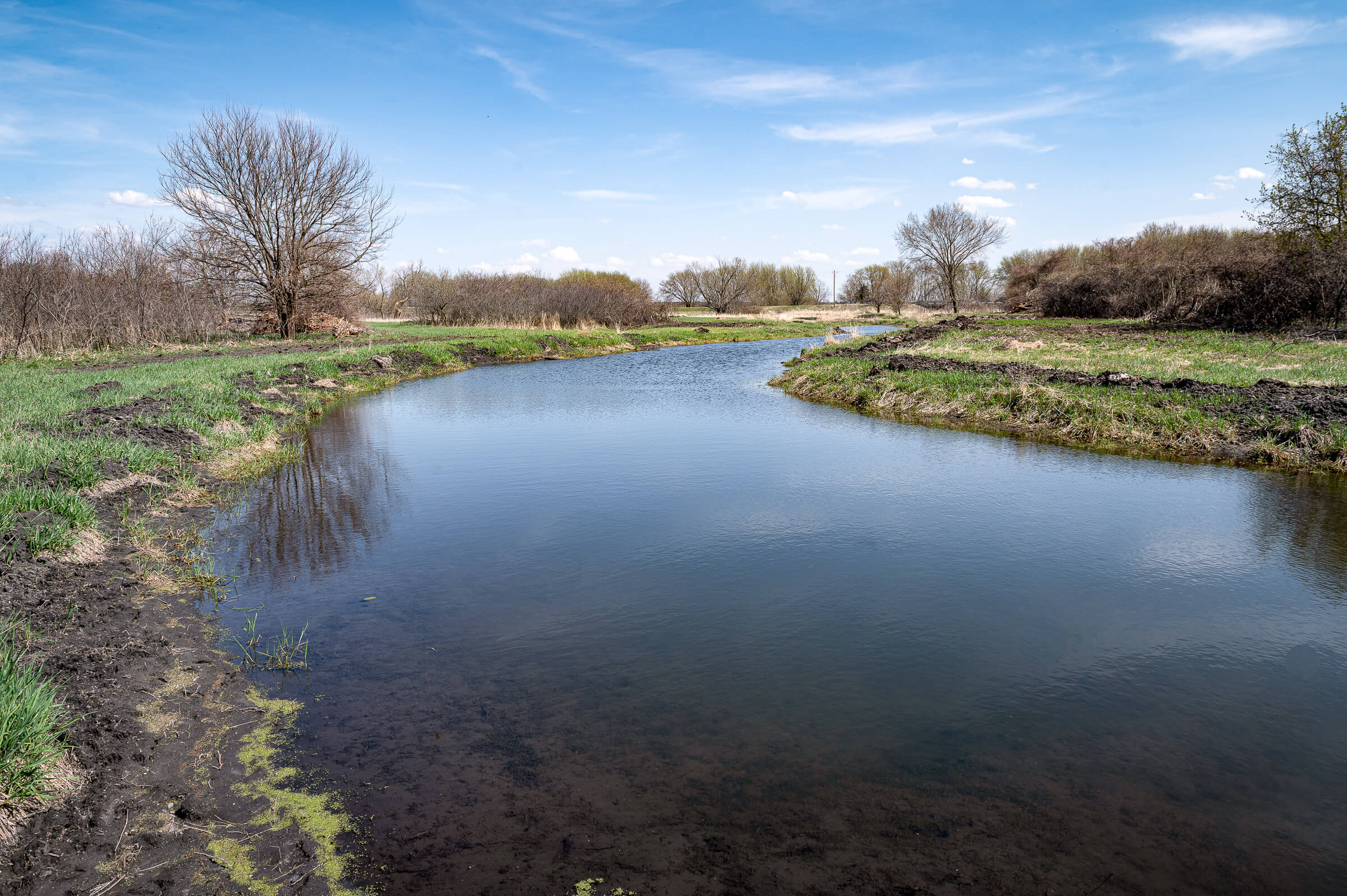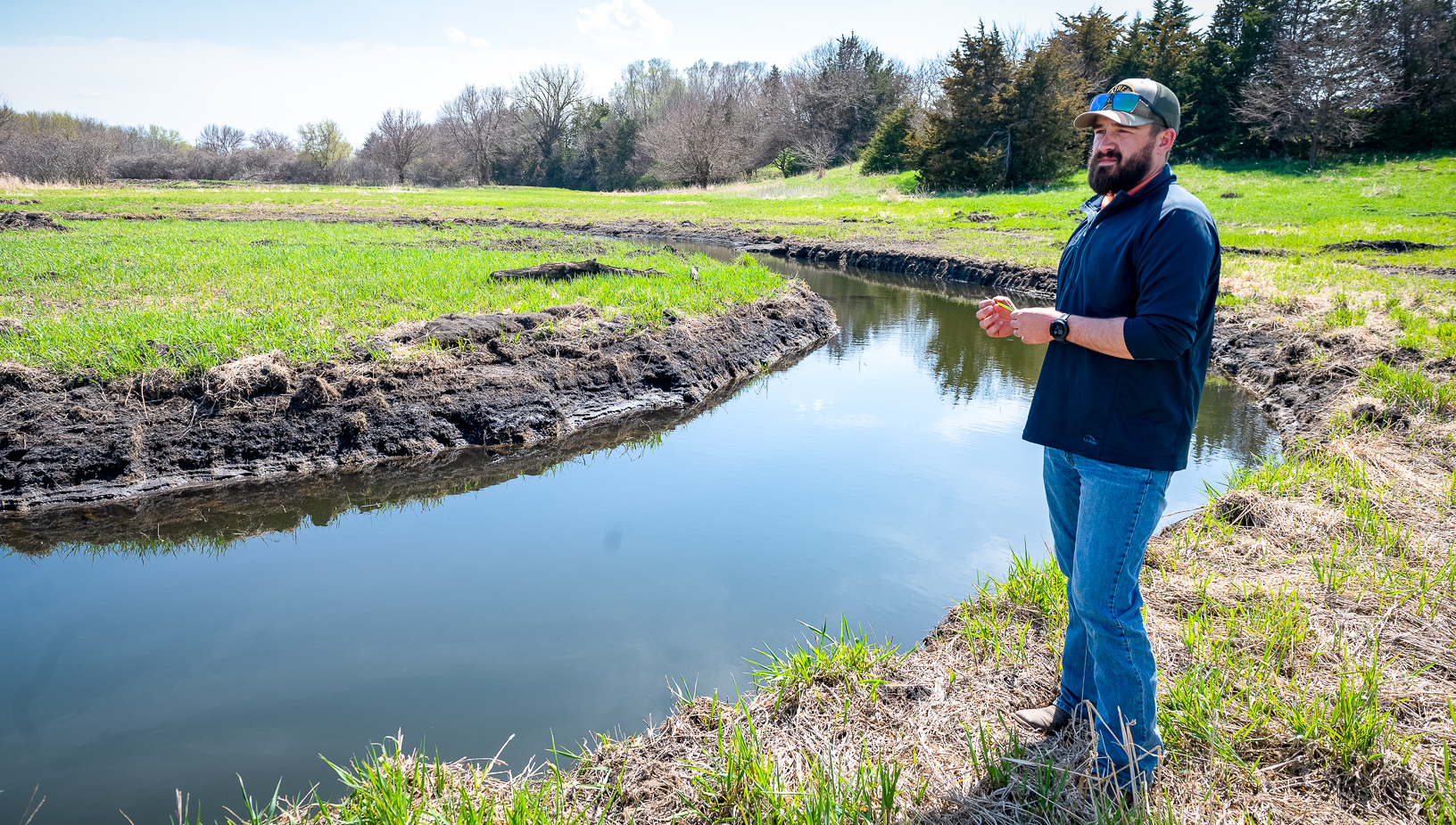
(Photo: Joseph L. Murphy/Iowa Soybean Association)
This article is part three of a three-part series by Darcy Maulsby, an ISA Communications contributor.
When Tom Mrazek was a boy, he loved spending time at Otter Creek near his family’s Renwick-area farm in north-central Iowa.
“I liked watching the fish,” says Mrazek, 30, who farms the land that has been in his family since the mid-1800s. “My dad and I would also seine (net) the creek to catch fish.”
As time went on, however, Mrazek noticed he wasn’t seeing as many fish in Otter Creek. His interest was piqued when Karen Wilke, an Iowa freshwater specialist and Boone River project director with The Nature Conservancy (TNC), contacted the Mrazek family in 2018. She wanted to see if they’d help restore oxbows along Otter Creek to provide habitat for the Topeka shiner, a tiny, silver, endangered minnow.
Oxbows are created when a creek or river cuts off a meander loop as it migrates within its floodplain. Over time, they can fill with sediment. When the sediment is removed, restored oxbows provide important habitat for many aquatic species. The Topeka shiner, which has been on the endangered species list since 1998, is one of them. Oxbows can also dramatically reduce nitrate leaving farm fields and entering creeks and rivers.
“Otter Creek didn’t go 50 yards without winding one way or the other, so I knew about the oxbows,” says Mrazek, who saw these non-farmable areas fill up with about 1 foot of water during wet years. “My dad and I thought it would be neat to restore the oxbows to help bring back native fish and have more species diversity on our land.”
Where did the Topeka shiners go?
The Topeka shiner once thrived in the many prairie streams flowing across Iowa and parts of Kansas, Missouri, Nebraska, South Dakota and North Dakota.
“The Topeka shiner is a plucky little fish that’s adapted to the streams and backwaters, wetlands and oxbows that were once abundant on the Midwestern landscape,” says Dr. Clay Pierce, an assistant professor in the Department of Natural Resource Ecology and Management at Iowa State University.
After people altered the landscape through agriculture, stream straightening and bridge building, Topeka shiners struggled as streams became deeper and water moved through them much faster.
“Topeka shiners need slow-flowing water, or pooled areas to live in and reproduce,” says Aleshia Kenney, a biologist with the U.S. Fish and Wildlife Service who has been restoring Topeka shiner habitat in Iowa since 2008.
Today, Topeka shiners are found only in small portions of west-central and north-central Iowa, as well as eastern South Dakota and Kansas and tiny sections of Nebraska and Missouri.
Wilke says in Iowa, Topeka shiners are primarily found in the North Raccoon and Boone watersheds, as well as the Rock River watershed and Little Rock River watershed in northwest Iowa.
These trends are important, Kenney says, because Topeka shiners are an indicator species.
“These minnows can handle much lower water quality parameters than many other fish species. If Topeka shiner numbers are low in an area, there's a good chance that many other species could also be decreasing.”
Building a culture of conservation
That’s why the Iowa Soybean Association (ISA) and partners, including Syngenta, The Nature Conservancy, U.S. Fish and Wildlife Service and others, have been working together to restore more habitat for species like the Topeka shiner.
One solution includes restored oxbows. They provide additional conservation benefits including improved water quality. The success of these efforts has led to nearly 150 restored oxbows throughout Iowa.
Wilke, who has been restoring oxbows for nearly seven years, says the TNC has recorded 54 different bird species utilizing them. They include great blue herons, pheasants, indigo buntings, swamp sparrows, marsh wrens and Nashville warblers. The Audubon Society said at least nine of these species wouldn’t have been there if it weren’t for oxbow restorations.”
Oxbows are also an approved practice for the Iowa Nutrient Reduction Strategy, a science-based framework to reduce nutrient loads in Iowa waters and the Gulf of Mexico. Underground ag tile drainage lines in farm fields can be routed through restored oxbows. When an oxbow intercepts this drainage water, microbes in the ecosystem remove an average of 50 percent– and as much as 95 percent – of the nitrate before the water is released into the creek, Kenney says. This helps improve water quality in Iowa and beyond.
“Oxbows are a piece in the puzzle of how we might reverse the trend toward exporting large amounts of nitrate from our croplands to downstream waterways in Iowa and other Midwestern agricultural states,” says Dr. Clay Pierce, an assistant professor in the Department of Natural Resource Ecology and Management at Iowa State University.

Corey McKinney a conservationist with the Iowa Soybean Association works with land owners and farmers to restore oxbows. (Photo: Joseph L. Murphy/Iowa Soybean Association)
Build it and they will come
While they don’t work everywhere, restored oxbows can fit specific sites. From a farming perspective, oxbows are seasonally wet, unproductive areas. “We’re not creating new oxbows; we’re restoring them where they naturally occur,” says Corey McKinney, an ISA conservationist.
To restore an oxbow, sediment is removed from the oxbow scar (the area where the oxbow occurred naturally) to a depth of 4 to 6 feet. The rich soil is spread on row-crop acres. Restored oxbows are typically one-fourth to one-half-of-an-acre in size. Some can cover up to 2.5 acres.
“The restored oxbow helps control flooding and becomes a small pond that can be used to water livestock,” says McKinney, who adds that the area around the oxbow is seeded with native plants to attract pollinators.
It typically takes 3-4 months to complete an oxbow restoration, depending on the weather, McKinney says.
There’s no need to stock fish in restored oxbows, which often fill with aquatic species within a matter of weeks.
“We call these ‘fish nurseries,’” says Kenney, who has restored 80 oxbows. “We collected 14,000 fish of 23 different species in one half-acre oxbow that prior to restoration dried up every year.”
The process of restoring an oxbow can be turnkey for the landowner, says Kenney, who adds that a half-acre oxbow restoration typically costs around $10,000 in the North Raccoon and Boone River watersheds. Funding for oxbow restoration is available through various sources, including the Environmental Quality Incentives Program (EQIP). In many cases, this funding can cover 100 percent of the cost.
“The whole process is really easy,” said Mrazek, who restored four oxbows on his farm in 2019. “It just took a few phone calls and a few trips to the field.”
Restored oxbows require little to no maintenance and will provide conservation and water-quality benefits for decades to come. ISA is working with its partners to restore 35 oxbows in the Boone and North Raccoon River watersheds in the next five years.
“I see a lot of opportunities for more oxbow restorations in Iowa,” Wilke says. “Oxbows are small, simple things that have big, long-lasting impacts.”
Mrazek enjoys the wood ducks, geese, teals and other wildlife at his restored oxbows. “My family and I love the land and want to leave it better than we found it.”
For more information or to discuss habitat restoration opportunities and suitability, contact ISA’s McKinney at cmckinney@iasoybeans.com or 515-334-1077.